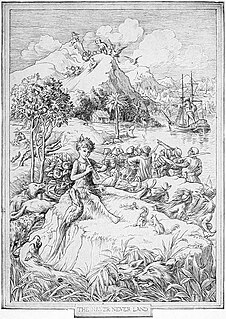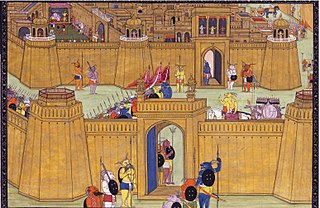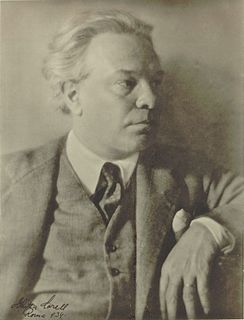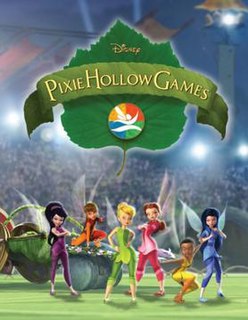
The Sunken Bell (German : Die versunkene Glocke) is a poetic play in blank verse by Gerhart Hauptmann (2. December 1896 in Berlin).

The Sunken Bell (German : Die versunkene Glocke) is a poetic play in blank verse by Gerhart Hauptmann (2. December 1896 in Berlin).
It is a fairy drama, the chief human character of which is Heinrich, a master bellfounder who has completed his crowning work, a bell which is to be hung in a church on a mountain inhabited by sprites. Through the hostility of the sprites, the wagon bearing the bell is overthrown and the latter is sunk in a mountain lake. Heinrich is injured and is nursed by the chief personage of the drama, Rautendelein, half child, half fairy, whose love changes Heinrich's standards and brings about the death of his wife.
This article includes a list of references, related reading or external links, but its sources remain unclear because it lacks inline citations .(July 2013) |

A fairy is a type of mythical being or legendary creature found in the folklore of multiple European cultures, a form of spirit, often described as metaphysical, supernatural, or preternatural.

Neverland is a fictional island featured in the works of J. M. Barrie and those based on them. It is an imaginary faraway place where Peter Pan, Tinker Bell, Captain Hook, the Lost Boys, and some other mythical beings and creatures live.

Lanka is the name given in Hindu epics to the island fortress capital of the legendary asura king Ravana in the epics of the Ramayana and the Mahabharata. The fortress was situated on a plateau between three mountain peaks known as the Trikuta Mountains. The ancient city of Lankapura is said to have been burnt down by Hanuman. After its king, Ravana, was killed by Rama with the help of Ravana's brother Vibhishana, the latter was crowned king of Lankapura. The site of Lankā is identified with Sri Lanka. His descendants were said to still rule the kingdom during the period of the Pandavas. According to the Mahabharata, the Pandava Sahadeva visited this kingdom during his southern military campaign for the rajasuya of Yudhishthira.

Tinker Bell is a fictional character from J. M. Barrie's 1904 play Peter Pan and its 1911 novelisation Peter and Wendy. She has appeared in a variety of film and television adaptations of the Peter Pan stories, in particular the 1953 animated Walt Disney picture Peter Pan. She also appears in the official 2006 sequel Peter Pan in Scarlet by Geraldine McCaughrean commissioned by Great Ormond Street Hospital as well as the "Peter and the Starcatchers" book series by Ridley Pearson and Dave Barry.

Rusalka, Op. 114, is an opera by Antonín Dvořák. The Czech libretto was written by the poet Jaroslav Kvapil (1868–1950) based on the fairy tales of Karel Jaromír Erben and Božena Němcová. A rusalka is a water sprite from Slavic mythology, usually inhabiting a lake or river. Rusalka was the ninth opera Dvořák composed. It is one of the most successful Czech operas, and represents a cornerstone of the repertoire of Czech opera houses.

Other than the many gods and goddesses of the Slavs, the ancient Slavs believed in and revered many supernatural beings that existed in nature. These supernatural beings in Slavic religion come in various forms, and the same name of any single being can be spelled or transliterated differently according to language and transliteration system.
A sprite is a supernatural entity in European mythology. They are often depicted as fairy-like creatures or as an ethereal entity.
In Scottish and Northern English folklore, a shellycoat is a type of bogeyman that haunts rivers and streams.
Fairies, in the fantasy series Artemis Fowl by Eoin Colfer, are fictional beings, usually shorter than a human, who possess magic properties. The average height of a fairy is exactly one meter, one centimeter. All the fairies have retreated below the Earth to escape the destructiveness of the human race. Their underground civilization is centered on the capital city of Haven. Fairies are vernacularly known as the People, and live a life according to the Book of the People. There are eight recognized families of fairies – Elves, Dwarves, Pixies, Gnomes, Gremlins, Goblins, Sprites and Demons. However, the centaurs have been mentioned several times, as with trolls, and the centaurs' cousins, the unicorns, were killed off, yet they are not recognized.

La campana sommersa is an opera in four acts by Italian composer Ottorino Respighi. Its libretto is by Claudio Guastalla, based on the play Die versunkene Glocke by German author Gerhart Hauptmann. The opera's premiere was on 18 November 1927 in Hamburg, Germany. Respighi's regular publisher, Ricordi, was displeased by his choice of subject, and refused to publish the opera. This led to its being published by the German publisher Bote & Bock, and a German premiere.

Folklore of the Low Countries, often just referred to as Dutch folklore, includes the epics, legends, fairy tales and oral traditions of the people of Belgium, Netherlands and Luxembourg. Traditionally this folklore is written or spoken in Dutch.

Tylwyth Teg is the most usual term in Wales for the mythological creatures corresponding to the fairy folk of English and Continental folklore and the Irish Aos Sí. Other names for them include Bendith y Mamau, Gwyllion and Ellyllon.
The works of J. M. Barrie about Peter Pan feature many characters. The numerous adaptations and sequels to those stories feature many of the same characters, and introduce new ones. Most of these strive for continuity with Barrie's work, developing a fairly consistent cast of characters living in Neverland and the real-world settings of Barrie's stories.

King Goldemar is a dwarf or kobold from Germanic mythology and folklore. By the Middle Ages, Goldemar had become the king of the dwarfs in German belief. In the fairy tale "The Friendship of the Dwarfs", the author Villamaria depicts Goldemar as a "mighty dwarf king" with a queen and a court of dwarf nobles at his service. He has long, silver hair and beard and wears a crown and a purple mantle. In one tale, he runs away with the daughter of a human king. Fragments of an epic poem by Albrecht von Kemenaten called Goldemar survive. The poem tells of Dietrich's encounter with the dwarf king. The king also features in "Der junge König und die Schafërin" by German poet Ludwig Uhland. Goldemar's brothers, Alberich or Elberich and Elbegast, feature in other poems.

The Starlight Express is a children's play by Violet Pearn, based on the imaginative novel A Prisoner in Fairyland by Algernon Blackwood, with songs and incidental music written by the English composer Sir Edward Elgar in 1915.

The Earl and the Fairy is a completed series of light novels written by Mizue Tani and published in Japan by Shueisha. The story is serialized in Cobalt magazine and illustrated by Asako Takaboshi (Ayuko).

Pixie Hollow Games is a 30-minute television special broadcast on November 19, 2011, on Disney Channel. Based on the Disney Fairies franchise, it was produced by DisneyToon Studios and animated by Prana Studios. It features the voices of Mae Whitman, Lucy Liu, Raven-Symoné, Megan Hilty, Angela Bartys, and others, as Tinker Bell and the other fairies of Pixie Hollow in Never Land, taking part in an Olympic-style competition. It is based loosely on J. M. Barrie's Peter Pan stories, by way of Disney's animated adaptation.

Knytt Underground is a 2D adventure game in the exploration subgenre similar to Metroidvania games, with elements of arcade platformers, combining the mechanics of the developer's previous games, Knytt and Within a Deep Forest. It was developed by Swedish programmer Nicklas Nygren and released in late 2012, with the PlayStation platforms PS3 and Vita seeing the first launch. The game offers two playable characters, nonlinear gameplay, multiple endings, and a large number of side-quests and secrets.
The Sunken Bell is an 1896 poetic play in blank verse by Gerhart Hauptmann.